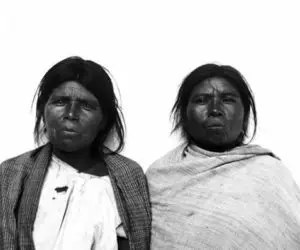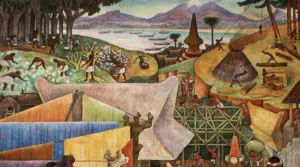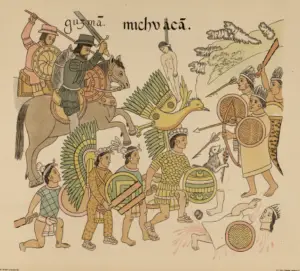Podcast: Play in new window | Download
Subscribe: Apple Podcasts | RSS
 At the time of the Spanish Conquest an indigenous kingdom existed in the modern Mexican states of Michoacan, Jalisco and Guanajuato. The people of the kingdom were called the Tarascans by the Spanish, but they called themselves the Purépecha. These people managed to evade conquest by the Aztecs, made peace with the Spanish without massive bloodshed and have preserved their language and culture well into the 21st Century. Here are 5 legends of the Tarascan or Purépecha people which date back many hundreds of years.
At the time of the Spanish Conquest an indigenous kingdom existed in the modern Mexican states of Michoacan, Jalisco and Guanajuato. The people of the kingdom were called the Tarascans by the Spanish, but they called themselves the Purépecha. These people managed to evade conquest by the Aztecs, made peace with the Spanish without massive bloodshed and have preserved their language and culture well into the 21st Century. Here are 5 legends of the Tarascan or Purépecha people which date back many hundreds of years.
The Earrings of the Moon
An old Purépecha legend tells of how for many thousands of years the Sun and the Moon were married and were very happy living in the heavens. Their peaceful lives changed when Citalimina arrived in the sky, known to modern-day peoples as the planet Venus, the star of the morning and evening skies. When the young and very feminine Venus first came on the scene, everything changed.
One day, the Moon found the Sun talking to Venus. The Moon became jealous of her because Venus was a very beautiful star with a very long hair. The Moon accused the Sun of flirting with Venus and so the formerly peaceful and happy celestial duo began fighting and insulting one another. They fought physically, too, and as the Sun was stronger than poor Luna, it left her face full of bruises, which are the craters we can see on its surface from Earth if we observe it carefully.
The Moon decided to separate from the Sun and went very far, they did not talk anymore; that’s why one goes out during the day and the other at night. Naturally, this caused the formation of day and night on Earth. When the two heavenly bodies happen to come together in the skies, they once again become lovers who embrace at that time eclipses occur.
When the Moon and Sun separate again, the Moon begins to cry a lot for the sadness it gives her, and each tear that falls to the Earth turns into drops of silver, which the Purépecha women collect to make beautiful earrings that are shaped like a half moon, with silver tears hanging from them.
When the Moon does not cry much, but only little, its tears do not turn into silver but into fresh drops of dew, which turn into what the Tarascan people call charauescas, which are yellow, orange or red flowers that look like dahlias; then, children dig into the earth to extract the sweet and watery jícamas that are the roots of the flower, which also quench the thirst of those who eat them.
To remember the gift that the Moon has given to women and the lessons of Venus, they should never cut their hair, and if they do, it has to be when there is New Moon, when it acquires the name of Xaratanga, the moon goddess or the goddess of the night of the Purépecha people.
 Princess Eréndira
Princess Eréndira
Many centuries ago, when the Spanish invaded Mexican lands to conquer them, a captain with his troops came to the territory of the Tarascans in modern-day Michoacán. He was going to meet the Purépecha emperor, Tangaxoan, who had a beautiful daughter whom he had named Eréndira.
The young princess Eréndira was very beautiful, and upon seeing her the captain fell deeply in love with her. One day, the Spanish captain kidnapped the pretty girl and hid her in a green valley surrounded by many mountains. Eréndira was very sad and suffered a lot. She longed for her house, her mother and her father.
She was so desperate that the gods of the Day and the Night, called Juriata and Xaratanga, heard her tragic sobs and decided to help her. They made the tears that flowed from the princess’s eyes become very strong and powerful. In no time her tears began to form a puddle that, little by little, became a large lake. The gods with their powerful magic turned Eréndira’s legs into a beautiful fish tail. She had become a pretty mermaid, also called a tlanchana.
Now the valley had a new lake which they named Lake Zirahuen. Eréndira never forgot the lake for which she had been saved, and since then, the people who live in the area say that the princess swims at night in the beautiful lake, and that at dawn she leaves the water to enchant the men who are bad.
The Tragedy of Hupanda
Hapunda, a word in the Purépecha language which now means “lake” or “lagoon,” in English, was once the name of a beautiful princess who lived on the island of Yunuén, one of the eight islands that are located in Lake Pátzcuaro, in the modern-day Mexican state of Michoacán. Seven such islands are currently populated. The island of Yunuén and Pacanda, form a group; another group is comprised of the islands of Tecuena and Tecuanita. The Urandes Islands makes up the third group. “Urandenes” is a name that comes from the Tarascan word urani, which means “batea” or “dough mixing bowl.” The last group is formed by the Jarácuaro and Copujo Islands. Apart from these islands, the famous Janitzio Island is located in the lake.
 The beautiful island of Yunuén has its meaning derived from the Tarascan term for “Half Moon”, because the island has a curved form like a moon. As already mentioned, on the half-moon island there lived a very beautiful and very good princess named Hapunda, the daughter of an important indigenous nobleman. Hapunda was so attractive that the Chichimec invaders decided one day to kidnap her to give her to the leader of the Chichimecs. When the brothers of the sweet princess heard about it, furious at the audacity of the Chichimecas, they prepared to go after the Chichimecs, which was a nomadic tribe from the northern areas of modern-day Mexico. Princess Hapunda knew that the military forces were in favor of the Chichimecas and that the Purépecha were going to lose and battle against them. The princess went to the shores of Lake of Patzcuaro, to tell the spirits of the lake about the terrible tragedy that was coming.
The beautiful island of Yunuén has its meaning derived from the Tarascan term for “Half Moon”, because the island has a curved form like a moon. As already mentioned, on the half-moon island there lived a very beautiful and very good princess named Hapunda, the daughter of an important indigenous nobleman. Hapunda was so attractive that the Chichimec invaders decided one day to kidnap her to give her to the leader of the Chichimecs. When the brothers of the sweet princess heard about it, furious at the audacity of the Chichimecas, they prepared to go after the Chichimecs, which was a nomadic tribe from the northern areas of modern-day Mexico. Princess Hapunda knew that the military forces were in favor of the Chichimecas and that the Purépecha were going to lose and battle against them. The princess went to the shores of Lake of Patzcuaro, to tell the spirits of the lake about the terrible tragedy that was coming.
The princess stood at the shores of Lake Patzcuaro surprised because the lake was talking back to her. In an audible deep male voice, the body of water advised the frightened princess that what she had to do was to throw herself into the lake and join him forever. “I will protect you, my princess,” the lake told the girl. “You must make yourself one with me.” Hapunda, very obedient and conflicted by emotions, jumped into the welcoming waters. Shortly after going underwater, the princess resurfaced as a white heron, to live forever in the lake and be nourished by its peaceful waters. After a certain time, more herons arrived to populate the island and can be seen in and around Lake Patzcuaro to this day.
The Lady of the Waterfall
A legend from Tepuxtepec, Michoacán tells that at the waterfall of El Salto, in the modern-day municipality of Contepec, a group of Tarascan youths went swimming on a hot summer day. Even though they knew the danger they were in, they decided to defy fate and go swimming near a waterfall and a fast stream. The boys were enjoying the cool waters, already very late, under a beautiful full moon, when suddenly they saw a woman dressed in a white robe. The lady was very beautiful, her long hair of a black crow’s wing reaching beyond her waist. Her skin was extraordinarily white, almost as much as her dress. The woman walked, or rather levitated, along the riverbank where the waterfall was. She was crying piteously and heartbreakingly.
When they saw her, the boys realized that she was getting closer to them. They were excited, because they thought that the woman was going to swim and so they could see how beautiful she looked up close. However, as they approached her, they all felt a terrible chill and the sensation that their hair stood on end.
At once, they all jumped out of the water and began to run, fleeing from the terrible shriek that the ghostly woman in white cast. The next day, all the daring young people were sick, they could not eat, they could not sleep, and when they did they suffered from terrible nightmares.
One of the mothers of the frightened boys, desperate to see her son in such a state of fright, decided to go to a healer. The mothers gathered all the boys and the witch proceeded to make them “clean” with special herbs. Fortunately everyone was cured of fright, and never returned to the waterfall where they had appeared so sinister a woman. To this day people avoid swimming in this area so that they won’t cross paths with “The Lady of the Waterfall.”
 The Origin of Cerro del Tecolote
The Origin of Cerro del Tecolote
In the 12th century, the Purépecha people guided by Iré-Ticatame arrived in the Zacapu region. The leader liked the area very much and decided to settle in such a beautiful place. He built a temple to worship Curicaveri, the patron god of the group. Shortly after, he offered his friendship and support to the local chieftain of Naránxhan, called Zirán-Zirán, as long as they carried firewood, regularly, to the Curicaveri temple to make the sacred fire in his honor. Zirán agreed and offered Iré-Ticatame his daughter, Pisperama, also known as “The Marvelous Flower” to be his wife. From the union was born Sicuir-Achá, whose name in English means, “The Lord in Fur Dress.”
After a while, Iré-Ticatame found his son making an arrow to kill off some of the Naránxhan people, because they had stolen the sacred deer that the young man had hunted as a tribute to the gods. Suddenly, a group of Naránxhans attacked the father and son and they fled quickly. Soon after, the transgressors surprised Iré-Ticátame to kill him. The Purépecha leader defended himself against many of the enemies using the sacred arrows that the gods had given him, but they were not enough. He had many vengeful enemies and the brave warrior fell dead.
When Pisperama learned of the death of her husband, she placed him on an altar specially prepared, covered her body with flowers and with the sacred arrows, formed a pyre and lit it. The pyre with the corpse and the flowers grew in such a way that it formed a huge hill, which with the fire of the brave warrior’s pyre became the largest volcano in Zacapu – which is known today as Cerro del Tecolote – which immediately started erupting non-stop. Sucuir-Achá, the son of Iré-Ticátame, became so enraged at the murder of his father that he killed off all the Naránxhans. This act calmed the terrible wrath of the volcano and it quietly fell asleep. Since then Iré-Ticátame, watches over his beloved Tarascan people, turned into a beautiful volcano three thousand and five meters high.
REFERENCES:
Taken from the mitosmexicanos web site (in Spanish)

4 thoughts on “Legends of the Tarascan People”
Thank you for sharing these beautiful stories with the world . This is my heritage and I am very grateful
You are most welcome!
I love my heritage 😍 thank you
Thank you! I truly enjoyed reading these stories from my people.